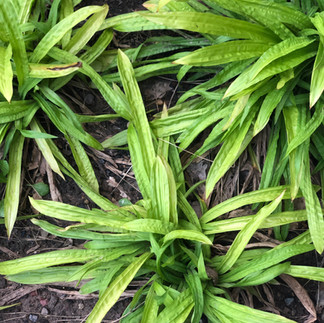Welcoming Woodland Garden: Could it be Native?
- Nuts for Natives
- Apr 24
- 4 min read
Updated: Apr 25
Front yard that says come on in!

This front garden creates such a sense of invitation. You enter from the right, passing between the two beds of groundcover on either side of the path. You can then head to the front door or detour to the perfectly placed bench. I have always admired this garden for the warmth the design conveys. It is also a very common set of circumstances here in Chesapeake country: a front yard with a large tree that casts a good deal of shade.
The outside edge of the garden design is very simple, using just a few types of plants. The center bed adds the excitement with texture and contrast. The positioning of the faux bois bench requires you to enter the heart of the small garden to reach your seat. This garden looks good in spring, summer, fall and winter too.
Most of these plants are 'introduced' from areas far from here. Is it possible to recreate this wonderful garden with natives? You know it is!
Evergreens
The multiple layers of evergreens are key to this garden's structure and year round interest. The evergreens are layered in height from the very tall hedge screening the neighbor's house, to the large round shrubs to low boxwood hedging in the center and groundcover on either side of the front path. To replicate the year round interest of the garden, it is important to keep the same layering of evergreens.
At the back of the garden, cherry laurel creates a tall hedge screening the garden from the neighbors' driveway. While there is a native cherry laurel (Prunus caroliniana) that grows in zones 7 through 11, the cherry laurels most often planted and sold in our area are English cherry laurels (Prunus laurocerasis). A native alternative to this hedge is American holly (Ilex opaca). While the trees can grow upwards of 40 feet, American holly can easily be pruned to form a hedge.
Three boxwood shrubs complete the larger evergreen edge to the garden. I believe these are Japanese boxwoods (Buxus microphylla var. japonica). While there is a type of boxwood known as American boxwood (Buxus sempervirens), it is confusingly native to Europe, Asia and parts of Africa.
A super native alternative is inkberry (Ilex glabra). Inkberry grows well in sun and tolerates part shade. The straight species grows up to ten feet tall and about five feet wide. In this garden, it would seem the location of the left and right boxwoods would have enough sun to accommodate inkberry. For the boxwood along the property line which is more shady, it might be better to extend the American hollies to the front in lieu of trying something else in such deep shade. To be sure, inkberries have a more natural shape than boxwoods.
The first layer of shorter evergreens is another row of boxwoods. Replacing the non-native boxwoods with one of the smaller cultivars of inkberry such as 'gembox' would create a very similar effect.
The second layer of shorter evergreens looks to be a cultivar of variegated euonymus (Euonymus japonica). The variegation in color adds a contrast to the solid green row behind. You could create the contrast with color or a different texture. To continue with a short evergreen, you could use one of the small cultivars of eastern white pine such as dwarf eastern white pine (Pinus strobus 'nana'). These are very, very slow growing cultivars of the eastern white pine tree. They can, over time, reach heights of 6 feet so to work in this garden, pruning would at some point in the future be required. Another less expensive option would be to plant a row of heuchera 'Autumn Bride' (Heuchera villosa 'Autumn Bride'). The perennials are semi-evergreen, lighter in color and add a different leaf shape and white flowers from mid-summer through fall.
Deciduous Shrubs
It is difficult to see in the photo but there is a row of Asian azaleas growing behind the bench, They are blooming with a deep burgundy red flower. One of the native azaleas such as the pinxterbloom azalea (Rhododendronpericyclymenoides) with pink blooms would be a good substitute.
Perennials

The creeping phlox (Phlox stolinfera) is native and adds a punch of color in early spring. You can find plants with white or lavender blooms as well.

The evergreens are punctuated with five cultivars of heuchera with burgundy foliage. The leaf shape and color create distinct contrast. Even though cultivars such as these with a changed foliage color are not thought to be as beneficial to insects as the straight species, I'd be inclined to keep the cultivars to give the extra added color contrast to the planting.
There are two perennials with blue foliage at the front of the bed. They may be lavender. I'd substitute blue wood sedge (Carex flaccosperma) in this part shade location. Bkue wood sedge is semi-evergreen so will add blue color and grassy texture most of the year.
Groundcover
The two swaths of evergreen groundcover are vinca (Vinca minor), now known to be invasive. A good substitute would be seersucker sedge (Carex plantaginea). It is semi-evergreen and adds a different texture. It does not spread as quickly or in the same way as vinca does. For a groundcover that spreads more readily, you could try green and gold (Chrysogonum virginianum) which is also semi-evergreen and spreads more readily.
A place to sit, a simple path off the front walk and capitalizing on the shade of a mature tree makes for quite the front yard respite. Add native plants and it nears perfection!
Happy gardening.















































Love what you did here offering choices of native alternatives.